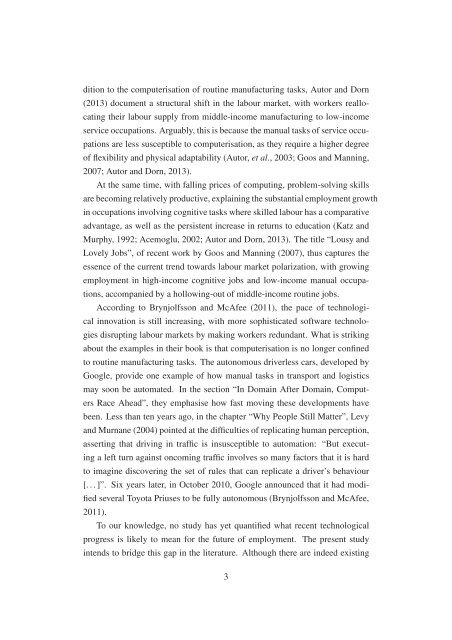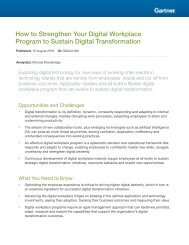The_Future_of_Employment
You also want an ePaper? Increase the reach of your titles
YUMPU automatically turns print PDFs into web optimized ePapers that Google loves.
dition to the computerisation <strong>of</strong> routine manufacturing tasks, Autor and Dorn<br />
(2013) document a structural shift in the labour market, with workers reallocating<br />
their labour supply from middle-income manufacturing to low-income<br />
service occupations. Arguably, this is because the manual tasks <strong>of</strong> service occupations<br />
are less susceptible to computerisation, as they require a higher degree<br />
<strong>of</strong> flexibility and physical adaptability (Autor, et al., 2003; Goos and Manning,<br />
2007; Autor and Dorn, 2013).<br />
At the same time, with falling prices <strong>of</strong> computing, problem-solving skills<br />
are becoming relatively productive, explaining the substantial employment growth<br />
in occupations involving cognitive tasks where skilled labour has a comparative<br />
advantage, as well as the persistent increase in returns to education (Katz and<br />
Murphy, 1992; Acemoglu, 2002; Autor and Dorn, 2013). <strong>The</strong> title “Lousy and<br />
Lovely Jobs”, <strong>of</strong> recent work by Goos and Manning (2007), thus captures the<br />
essence <strong>of</strong> the current trend towards labour market polarization, with growing<br />
employment in high-income cognitive jobs and low-income manual occupations,<br />
accompanied by a hollowing-out <strong>of</strong> middle-income routine jobs.<br />
According to Brynjolfsson and McAfee (2011), the pace <strong>of</strong> technological<br />
innovation is still increasing, with more sophisticated s<strong>of</strong>tware technologies<br />
disrupting labour markets by making workers redundant. What is striking<br />
about the examples in their book is that computerisation is no longer confined<br />
to routine manufacturing tasks. <strong>The</strong> autonomous driverless cars, developed by<br />
Google, provide one example <strong>of</strong> how manual tasks in transport and logistics<br />
may soon be automated. In the section “In Domain After Domain, Computers<br />
Race Ahead”, they emphasise how fast moving these developments have<br />
been. Less than ten years ago, in the chapter “Why People Still Matter”, Levy<br />
and Murnane (2004) pointed at the difficulties <strong>of</strong> replicating human perception,<br />
asserting that driving in traffic is insusceptible to automation: “But executing<br />
a left turn against oncoming traffic involves so many factors that it is hard<br />
to imagine discovering the set <strong>of</strong> rules that can replicate a driver’s behaviour<br />
[. . . ]”. Six years later, in October 2010, Google announced that it had modified<br />
several Toyota Priuses to be fully autonomous (Brynjolfsson and McAfee,<br />
2011).<br />
To our knowledge, no study has yet quantified what recent technological<br />
progress is likely to mean for the future <strong>of</strong> employment. <strong>The</strong> present study<br />
intends to bridge this gap in the literature. Although there are indeed existing<br />
3





